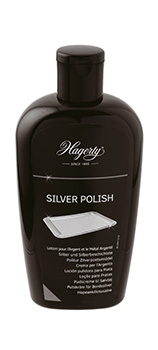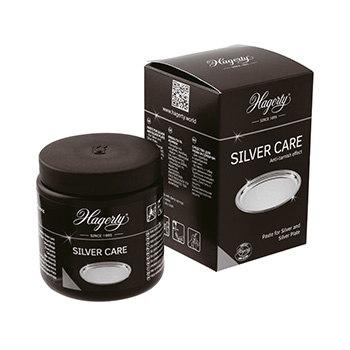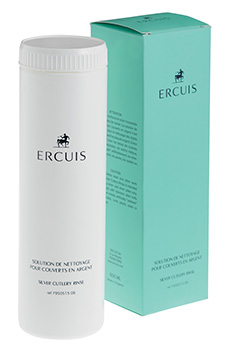-
Austria | English
-
Belgique | Français
-
Belgium | English
-
Bulgaria | English
-
Croatia | English
-
Czechia | English
-
Denmark | English
-
Estonia | English
-
Finland | English
-
France | Français
-
France | English
-
Germany | English
-
Greece | English
-
Hungary | English
-
Ireland | English
-
Italy | English
-
Latvia | English
-
Lithuania | English
-
Luxembourg | English
-
Netherlands | English
-
Poland | English
-
Portugal | English
-
Romania | English
-
Slovakia | English
-
Slovenia | English
-
Spain | English
-
Sweden | English
-
Suisse | Français
-
Switzerland | English
-
United Kingdom | English
WELCOME TO ERCUIS CUSTOMER SERVICE
Silverware might seems to need a lot of maintenance but in reality, it is very easy to take care of all your silverware product.
After long exposure to the air, silverware has blackens but it doesn't mean that the shine can't be restore.
When silverware has become tarnished, be careful to choose a product that is designed specifically for silver like our antitarnish gloves and chamois or soft cloth to apply silver polish or foam to clean your cutlery or holloware.
The use of the dishwasher is possible for all of our products with the exception of the Arts Décoratifs, L'Insolent and Calypso collections.
For all, it is recommended to:
- Place the silver and stainless steel flatware in different baskets, as well as the knives with steel blades.
- Use washing powder only (and especially not liquid or gel), Ercuis recommends “Calgonit” products.
- For sticky or greasy traces, the use of household alcohol is possible.
- For heavily stained cutleyr, a little water mixed with baking soda or vinegar will be perfect for removing any buildup on the pieces, always followed by a good rinse and a thorough drying.
- At the end of the cycle, open the door of the dishwasher to remove water vapor and avoid leaving the silverware in the dishwasher too long.
- When washing by hand, do not use bleach or rubber (gloves, elastic, rubber fabric), which contains sulfur and causes stubborn black marks.
- After washing, dry your silver and stainless steel cutlery and store it in a dry place.
Attention: sterling silver flatware with mounted handles should not be placed in the dishwasher, this will damage the precious and/or natural materials of their handles and would weaken the mounting.
Special care must be taken over cleaning these pieces, with their delicate sterling silver grille. Do not use asilver foam or impregnated mitts that might catch on the grille and damage it.
Place in a protective basket and immerse in a silver cutlery rinse for just a few seconds to restore all their brilliance. Then rinse in clear water and blot dry with a cloth.
For these two collections, the use of dishwasher is not possible.
Arts Décoratifs cutlery is not dishwasher-safe.
Their lacquered handles are not resistant to the high temperatures and detergents used in dishwashers.
Some people may be reluctant to purchase a piece of silverware because of its maintenance and the "oxidation" phenomenon: a piece turns black and fades in prolonged contact with air.
In fact, silver gradually loses its luster by first acquiring a yellow tint that becomes increasingly black over time. This phenomenon is more or less fast depending on whether the piece will be exposed to heat and humidity or not.
- The first advice for maintenance is frequent use. Indeed, since the staining appears rather slowly, the silver will not have time to darken between uses. In addition, its regular use automatically provides for cleaning and gives all the pieces the true “patina” of silver.
- Store the silverware and steel prducts in a dry environment, avoiding wet pieces. For sterling silver, use a soft cloth to separate each piece to prevent scratching.
- Use anti-oxidant covers for pieces not intended for interior decoration.
- It is not recommanded to use product that contains chlorine, rubber and acids as they can be too aggressive.
- For knife, it is recommended to avoid thermal shocks to prevent weakening the blade and handle assembly.
Attention: the coastal environment could also accelerate the oxidation process.
When a piece of holloware is oxidized, it is better to choose a specific product reserved for silver, such as a silver polish or a silver care cream, while following the instructions and using a soft cloth to apply the product.
The lacquered handle of the flatware is coated with a layer of protective varnish,and therefore does not require any special care.
The head of the flatware as well as its ferrule and finial should be cleaned with specially-formulated products for silverware.
- Antitarnish gloves and Chamois cloth
They are coated with a special polishing compound that helps to remove dirt, stains, and imperfections of decorative pieces.

- Silver polish
For slight oxidation, apply on a soft dry cloth and rub on the silverware item. Leave it on for a minute before rubbing it off with a dry cloth.

- Silver care cream
For more oxidized or stained items, dampen asponge in warm water and apply the cream. Clean it thoroughly before rinsing in clear warm water. Buff with a soft dry cloth to obtain a brilliant longer lasting luster.

- Silver cultery rinse
For Insolent and Calypso collections, immerse the cutlery in the silver cutlery rinse before washing it in clear water.

Safety information
Cutlery
Cutlery must be used and handled with care, the following are some guidelines for safe use.
- Appropriate use: Each piece of cutlery is designed for a specific use. Do not use cutlery for improper purposes.
- Integrity: Check the cutlery for defects such as loose handles, cracks or other breaks. Damaged cutlery could be dangerous during use, especially if the damaged part is a handle that could detach during use.
- Maintenance and cleaning: follow the use and maintenance instructions for the articles.
- Storage: store cutlery in a safe place and out of reach of children.
- When not in use, avoid leaving cutlery unattended on the edges of plates or surfaces where it could fall and cause damage or injury.
Knives
Incorrect use of the items can cause injury to the user or those around them. Therefore, it is essential to use them with caution and only for the purposes for which they were designed.
The main safety recommendations are given below:
- Secure grip: always hold the knife firmly with a firm grip. Keep fingers away from the blade to avoid the risk of accidental cuts.
- Appropriate use: Only use the knife for the purpose for which it was designed. Avoid using it for tasks that could damage the blade or cause accidents.
- Sharpening: Sharpen the knife regularly to ensure that it is effective and safe to use. Blunt blades can be more dangerous because they require more force to cut, increasing the risk of slipping and injury.
- Blade orientation: When not in use, hold the knife with the blade pointing downwards or so that the cutting edge is away from people.
- Stable work surface: Use the knife on stable, non-slip work surfaces to reduce the risk of accidental slipping.
- Never leave knives unattended: When not in use, store the knife in a safe place, such as a stand or closed drawer. Keep out of reach of children.
- Care when washing: When cleaning, handle the knife carefully, avoiding touching the blades with bare hands. Use protective gloves or cloths if necessary.
- Do not force the knife: Do not use the knife on materials that are too hard or for tasks that require too much force, as this may cause damage to the blade or increase the risk of injury.
- Caution when carrying the knife: When carrying a knife, always hold it with the blade pointing downwards and never with the blade pointing upwards to avoid accidental injury.
Cookware and lids
Improper use of the items could result in injury to the user or those around them, so it is recommended that they be used only for the purpose for which they were designed. For the safe use of cookware, it is important to follow some simple but fundamental recommendations to avoid accidents and ensure proper and safe use.
Here is the main safety information:
- Temperature control: never overheat an empty pot. If you leave a pan on a heat source without food or liquid inside, it could be damaged or overheat, causing a risk of burns or fire.
- Firm handle: Make sure that the handle of the pan is firm and does not become too hot during cooking. Use heat-resistant handles and, if necessary, kitchen gloves to protect yourself.
- Use appropriate utensils: avoid using metal utensils that could scratch or damage the non-stick coating of the cookware. Prefer utensils made of wood, silicone or heat-resistant plastic.
- Beware of hot vapours: When lifting the lid, beware of hot vapours which may suddenly escape. Hot air can cause burns if you are not prepared.
- Checking pans on the stove: Never leave a pan on the stove unattended, especially if it contains liquids or foodstuffs that could spill and cause fire or leakage. In case of high flames or smoke, switch off the cooker immediately.
- Stable positioning: Ensure that the pot is always firmly positioned on the hob surface. Do not place it on unstable or sloping surfaces that could cause accidental tipping.
- Handling hot pots with care: When handling hot pots, use potholders or oven gloves to avoid burns. Never touch the handles or body of the pot with your bare hands if they are hot.
- Regular and safe cleaning: after each use, clean the pot properly according to the manufacturer's instructions to avoid damage to the material. For non-stick cookware, avoid using abrasive sponges that could damage the coating.
- Avoid contact with cold surfaces: After removing a pot from the stove or oven, do not place it on cold or wet surfaces, as this may cause cracks or structural damage.
- Regular maintenance and inspection: Regularly check the condition of the cookware for damage such as loose handles, cracks or rust that could impair proper use. Comply with use and maintenance regulations.
Holloware
Improper use of the items could cause injury to the user or those around them, so it is recommended that they be used only for the purpose for which they were designed.
To ensure safe use of holloware, it is important to follow certain guidelines that help prevent accidents and damage, both to the user and to the items themselves. Here is the main safety information to consider:
- Appropriate use: use holloware only for the purpose for which it was designed. Avoid using containers that are not suitable for high temperatures (e.g. ceramic dishes that are not suitable for the oven) or baking containers for preparations that require too high temperatures.
- Avoid bumps and falls: Holloware, especially ceramic or glass crockery, can be fragile. Handle with care and avoid leaving heavy or sharp objects on top of the crockery. Avoid dropping or bumping it to prevent breakage or chipping.
- Checking for damage: Before each use, check the tableware for cracks, chips or damage that could compromise its safety. Damaged parts could cause injury during use or compromise the safety of operators.
- Overheating and temperature fluctuations: avoid exposing the holloware to extreme temperature fluctuations, such as going directly from the freezer to the oven or to a flame, as these can cause sudden breakage. If the crockery is suitable for the microwave or oven, always follow the instructions. Avoid placing food that is too hot in containers that are too cold, to prevent breakage due to temperature changes.
- Use suitable utensils: To avoid damage to coatings (especially for non-stick pans or enamelled pots and pans), use utensils made of wood, plastic or silicone. Avoid using metal utensils that could scratch or damage the cookware.
- Avoid direct contact with flames: some types of holloware, such as ceramic or earthenware, are not designed to come into direct contact with flames. Use them only on appropriate hobs and do not expose them directly to fire or intense heat sources.
- Respect use and maintenance rules.
- Proper storage: store holloware so that it is not damaged. Avoid stacking too heavy objects on top of more fragile containers. Use separators or paper sheets between the pieces to avoid knocks or breakage.
- Beware of vapours: when using holloware that contains liquids or hot food, beware of vapours that may escape, especially during cooking. Use kitchen gloves or potholders when handling hot holloware.
Kitchen utensils
Kitchen utensils, although essential for preparing meals, must be used with care to ensure safety and prevent accidents. Here is some general safety information for the use of kitchen utensils:
- Proper use: each utensil is designed for a specific purpose, so it is important to use it for the task for which it was intended.
- Maintenance of utensils: Always keep utensils in good condition. Dull blades, broken handles or damaged utensils can cause accidents.
- Safe storage: Store tools safely, out of reach of children or people who may not be able to use them properly. Use suitable holders or containers to prevent tools from falling or causing injuries.
- Care during use: Always use tools with due care, concentrating on their handling and positioning.
- Avoid damaged tools: Do not use tools with broken or damaged handles, as they may cause poor control or lead to injury.
Comply with use and maintenance regulations.
Electrics (EEE)
Improper use of the items could cause injury to the user or those around them, therefore it is recommended to use them only for the purpose for which they were designed
Refer to the safety instructions on the packaging or product box.
Cleaning products
Improper use of the products could cause injury to the user or those around them, therefore it is recommended to use them only for the purpose for which they were designed. Refer to the safety instructions on the packaging or product box.
